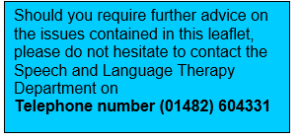- Reference Number: HEY-208/2023
- Departments: ENT
- Last Updated: 28 April 2023
Introduction
This leaflet has been produced to give you general information about your condition. Most of your questions should be answered by this leaflet. However, it is not meant to replace the discussion between you and your doctor or therapist, but may act as a starting point for discussion. If after reading it you have any concerns or require further explanation, please discuss this with a member of the healthcare team who has been caring for you.
What is Globus Sensation?
Globus sensation is a term used to describe the feeling of a lump in the throat where no true lump exists. It is extremely common and may be associated with hoarseness of voice.
What causes it?
The exact cause of globus is uncertain and it may be different in different individuals. One common link is increased tension in the muscles of the throat. There may also be irritation or swelling of the tissues lining the throat or an altered perception of how the throat feels. Globus may be associated with:
Stress and Anxiety
Globus can often be experienced by individuals at times of stress or anxiety. It often occurs when holding back strong feelings or emotions.
Acid Reflux
Laryngopharyngeal reflux, also referred to as ‘silent reflux’ is a condition in which the stomach acids travel up the food pipe and into the throat. It can be difficult to detect as individuals often do not get the symptoms of heartburn or indigestion, but it is commonly associated with chronic throat clearing, voice change and globus sensation.
Certain foods and drinks can also contribute to reflux. These include spicy foods, fried and fatty foods, acidic food, alcohol, and caffeine.
Tiredness
People will often describe their globus symptoms as being worse when they are tired. For example, at the end of the day, particularly if the day involved a lot of talking and voice use.
Voice strain
Using our voice for long periods, such as talking, public speaking, long phone calls, or speaking over background noise can lead to overuse or misuse of the voice and throat muscles. This can lead to increased muscle tension and globus.
Smoking
Smoking can make globus symptoms worse. It can cause an increase in stomach acid production and irritation in the throat.
Cervical Spondylitis
Some sufferers of this condition may experience globus due to increased tension in the neck and throat muscles.
Other associations
These can include; medication side effects or other medical problems such as; an enlarged thyroid gland.
How is Globus Sensation diagnosed?
Globus is usually diagnosed through discussions with you about your throat symptoms. These discussions may suggest possible causes of the globus. It is likely that you will have been examined by an Ear Nose and Throat Specialist in order to rule out any physical cause.
What is the treatment for Globus Sensation?
The treatment can be tailored specifically to the individual who is experiencing these symptoms and may include the following:
- Often reassurance that there is no serious underlying problem or disease may be all that is required to help you
- Adopting relaxation and distraction techniques as focussing on the symptoms may make them feel worse
- Stopping smoking
- Medication may be advised if there is evidence of acid reflux or post nasal drip
- Voice therapy with a Speech and Language Therapist may be recommended, if there is an associated hoarseness of voice
What can I do to help ease my symptoms?
Vocal hygiene/health
- Drink more water- aim for one and a half to two litres of water per day. Flavouring water with cordial may help you increase your intake. Continual sipping is most beneficial, as swallowing can relax the throat.
- Avoid drinking more than 4 cups of coffee/tea/cola per day. They can act as a diuretic, causing extra water loss from your body via your urine. They can also contribute to increased reflux symptoms for certain people.
- Reduce consumption or alcohol and trigger foods (fatty, acidic and spicy foods). Leave a break of 2-3 hours after eating dinner and going to bed. Ensure to sit upright after eating and try not to move around too much.
- Avoid shouting or throat clearing as these behaviours create unnecessary tension in the throat and can lead to globus sensation. Try to reduce throat clearing by doing an effortful swallow, take a sip of water or try doing a big ‘sniff’ then blow out through pursed lips.
Anti-reflux treatment
Take the appropriate anti-reflux treatment for gastric reflux, if this has been identified as a cause of your problem. Please note that ‘silent’ reflux can be present (where by you may not experience the associated heartburn but reflux is still present.)
Managing stress
Stress can make you tense and may increase the feeling of a ‘lump in your throat’. Observe ways in which you could reduce stress in your life, i.e. do your symptoms worsen in specific situations or at specific times of the day, take time out to work specifically on relaxation and try to relax by whatever means are realistic for you and your situation.
If you are feeling tearful, but stop yourself from crying this can also contribute to a feeling of a ‘lump’ in your throat. This is normal. Crying should help to ease the sensation.
Specific exercises
You may find the following beneficial provided you have no medical condition affecting the neck, shoulders or spine. If so, you should consult your doctor or physiotherapist first:
Start by becoming self-aware of your posture and positioning when you’re sitting and standing throughout the day. Think tall. Imagine a string running up your spine and out of the top of your head, pulling you up to the ceiling or sky. Your shoulders and arms should hang comfortably, try not to slouch forward. Your head should be balanced over your shoulders – not poking forward or pulled back.
Exercise 1 – Neck and Shoulders
- Drop your chin down towards your chest; hold it there for about 10 seconds before raising back to centre.
- Drop your head sideways towards your shoulder, keeping your shoulders straight. Hold it for 10 seconds before raising back to centre. Repeat on the opposite side.
- Shrug your shoulders up to your ears. Hold the position for a few seconds and then relax, dropping your shoulders to their resting position. Repeat this 5 times.
- Hold your arms out in front of you, as if you are pushing something away from you. Stretch out as far as you can. Gently drop your arms to your sides as you relax. Repeat this 3 times.
- Push your shoulders forwards as if attempting to make them meet at the front. Push your shoulder blades backwards as if attempting to make them meet at the back. Relax and repeat 5 times.
Exercise 2 – Abdominal Breathing
- Sit comfortably in a chair and place your hands on your tummy.
- Blow out sharply, as if blowing up a balloon. As you blow out, your tummy and hands should move in.
- Your shoulders and upper chest should be still and relaxed. At the end of the breath out, relax your tummy; it should expand naturally, allowing your lungs to re-inflate.
- When you feel comfortable with this technique, produce a soft /sss/ sound on the out-breath.
Exercise 3 – Laugh/Giggle
Laughing and giggling is a natural way to lose tension in the throat by widening the area where you may feel tightness or a ‘lump’.
Exercise 4 – Yawn / Sigh
Yawning is a very good technique for relaxing the muscles in the throat. As the name suggests, you yawn on an in-breath and softly release a sigh on an out-breath. In social situations, this exercise can be adapted to a half yawn into the back of the throat with lips closed.
Exercise 5 – Swallow hard
Swallowing hard on saliva or water helps to stretch the sphincter muscle (muscular valve) that lets food and drink pass down your gullet (food pipe). Stretching this muscle also opens the back of the throat around the area where some people can feel ‘a lump’ or something getting stuck.
Exercise 6 – Chewing method
This technique is used to relax tight jaws or tongues. Imagine you are chewing a toffee by moving your lips, tongue and jaw in a smooth, circular motion. Imagine the toffee is getting bigger and bigger so the movements in your mouth will need to get bigger and bigger.
Exercise 7 – Tongue movement
Moving your tongue slowly around the outside of your teeth with your lips closed also helps to get rid of tension from the larynx (voice box). Do this 10 times one way, then 10 times the other for one minute several times per day.
If, after trying these suggestions, your symptoms persist or new symptoms appear, please contact your GP

This leaflet was produced by the Speech and Language Therapy Department, Hull and East Yorkshire Hospitals NHS Trust and will be reviewed in April 2026

